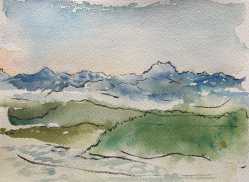>>2328278It's also worth noting that most of these are some of the cheapest paints you can get today. They're made of dirt, synthetic rocks, or used in the auto and plastics industries and are mostly non toxic. As long as you don't lick your brush or drink the wash water, even the heavy metals have a minimal risk.
I did forget to mention white gouache Sargent used in highlights and impasto, titanium is a smarter choice than china (lead) white because it doesn't oxidize into black. Purists consider using it heresy, but purists also use rose madder genuine and alizarin crimson.
On brands and hot takes. Winsor and Newton is expensive in the US, Daniel Smith is expensive, m. graham runs in darker shades and uses honey as a binder which makes it easy to rewet but will drip and run out in a hot bag. Other brands become increasingly less honest about what's in them. Student grade paints and pulp papers make many common techniques you'll read about difficult or impossible, but are fine if you know that.
Wash and dry your brushes immediately after use. Granulating pigments don't need Dawn, your phthlahlloho blues and nasty ass cadmium does. Your $12 synthetic squirrel quill appreciates it just as much as a kolinsky sable and will serve you better innawoods. Pouring out your clean water is fine no matter what braindead ecoterrorists say. Carry out your rinse water if you use heavy metals or can't pronounce the pigment, you should carry it out anyway but a basic sienna/ochre/ultramarine triad of the expensive shit is literally rocks and dirt held together with honey and has no detergents or brighteners to speak of. NGL, I've had a sip o the rinse.
Most importantly, have some fucking fun. My hot takes and love of classical watercolor works for me, do your own thing. It's never been respected academically and no one cares about it except for people who do it so you're free to do what you want. Field sketching and plien aire should be relaxing.

